The Letter Vahv וו as a Consonant /vahv/ = /v/
1.14.3100.00 %
When the vahv occurs as a consonant in the middle of a word, it is written twice to show that it has the sound of /
v/ and is not a vowel indicator for
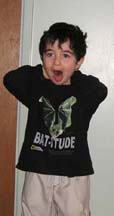 /
/
Write:
"bachelor" /rah-vahk/
רווק"hope" /tihk-vah /
תיקְווה"Neck" /tsa-vahr/
צוואר
(Notice that the
א in the word צוואר is not pronounced.)The letter
ג /GIH-mehl/ = /g/ Tamah3 as in "good" 1.14.4
100.00 %
Practice writing GIH-mehl __________________________________________________
ג"also" /gahm/_________________________________________
גם"holiday" /xahg/______________________________________
חג"minute, just a minute!" /REH-gah/_______________________
רֶגע"big" (m) /gah-dohl/ _________________________ גדול
"big (f.)" /ge-doh-lah/________________________________ גְדולה
Practice Reading:
גדול גְדולה רֶגע אחרֵי לְהקְשיב תיקְווה בְּקול
איי אוי אוּי Diphthongs: /ahy/, /ohy/, and /ooy/
1.14.6
A diphthong is a combination of two vowel sounds. For example: /ah/ + /ee/ = /ahy/ as in "rye". Notice that we write /ahy/ in Hebrew with a double yood as a signal to the reader not to read /ih/.
my songs" /shih-rahy/
שיריי
26
100.00 %
![]()
Listen, then
Write
"
enough" /dahy/_________________________________________ דיי"desirable" /rah-tsooy/___________________________________
רצוּי"oy" /ohy/______________________________________________
אוי"after me" /ah-xah-rahy/________________________________
אחריי

BUT...Inconsistencies do exist: for example, the dipthong /ahy/ with one yood /oo-lahy/ "perhaps"
אוּלי

שיר -

100.00 %
Here are the next two lines of the song you are learning: Practice
reading them.

A song is a beginning
שיר שיר הוּא התְחלהSing a song of great hope.
שירוּ שיר תיקְווה גְדולהNow copy these two lines in Hebrew. Read them from your own writing.
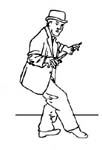 שיר שיר הוּא התְחלה
שיר שיר הוּא התְחלה
שירוּ שיר תיקְווה גְדולה
1.16 הדגֵש - THE DOT INSIDE A LETTER: /dah-GEHSH
![]() Use with Software Chapter 1:14 "The Use of
the Dagesh"
Use with Software Chapter 1:14 "The Use of
the Dagesh"
The dot, called a dah-gehsh, inside the letter
ב indicates that the letter has the sound /b/. However, in texts without nikkud the dah-gehsh דגֵש is omitted— even when the ב is to be pronounced /b/ and not /v/. (The דגֵש is included in poetry, prayer books and biblical texts since these texts include full nikkud.) In our course we will include the דגֵש at first, to help you during the initial period of learning Hebrew. Note that בּ and ב are simply alternate pronunciations of a single letter. They are not considered two separate letters— despite the difference in sound.27
 Although the several rules related to the use of the
Although the several rules related to the use of the

בּ Review: beht = /b/
ב veht = /v/ 1.16.1
![]()
Listen to all the audio, then write in the words
100.00 %
עברית____________
Hebrew מחְבֶּרֶת__________ notebook שבּת_____________ Sabbath במחְבֶּרֶת__________ in the notebookלְהקְשיב__________
to listen בקְבּוּק___________ bottleתֵל־אביב_______________________
Tel Avivשבּת שלום_____________________
Sabbath greetingּפּ
PEH = /p/ פ FEH = /f/ 1.16.2Look for the dot inside the letter.
As in the case of
בּ and ב, the /dah-gehsh/ דגֵש in the ּ פּ indicates how this letter is to be pronounced. Like the בּ and ב, the פּ and פ are only one letter, not two. The דגֵש is a mark to guide the reader in pronunciation. It is not supplied in Hebrew where the nikkud is not included! The פ is always /p/ at the beginning of a word, and /f/ at the end of a word. You will learn to know when to read a פּ as פ or בּ as ב as we proceed.28
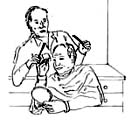

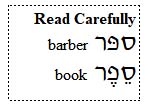
1.16.2.1 לקרוא ולִכְתוב Read and write these words and phrases
Look for the dot inside the letter:
Write feh_____________ פ Write peh ______________ פּ
100.00 %
![]() עוד
פּעם
עוד
פּעם
יופי
!slang) great) אֵיפֹה where מפְתֵח key1.17 ביטוּיים CLASSROOM PHRASES
100.00 %
Here are a few phrases that your teacher uses in class. You know most of the letters in these words. Listen and repeat in chorus as they are pronounced by your teacher.
בְבקשה בְּיחד בְּבקשה לְהקשיב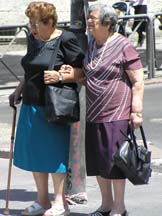
עוד פּעם! מהֵר מִדיי
לחזור אחריי
יותר גדול![]()
י - THE LETTER YOOD AS A CONSONANT -
1.18
יי
DOUBLE YOOD and י YOOD
![]() /yood/ at the beginning of a word 1.18.1
/yood/ at the beginning of a word 1.18.1
Remember: When writing yood, you begin at the height of the regular letters, but use only half of the line.____________________________
י29
When the yood appears at the beginning of a word, it sounds like /y/
100.00 %
יותֵר גדול
bigger יום dayיחד
together ימין (right (directionאני יודעת
(I know (f אני יודֵע ( I know (mיֵש
there is/are יופי slang) great)
yood/ in the Middle of a Word - 1.18.2
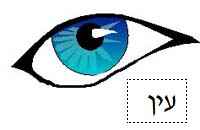
Because yood in the middle of a word could also be a vowel indicator, as in the word for "song"
שיר , Modern Hebrew often doubles the letter yood to signal its consonantal value as /y/. For example:100.00 %
"tourist" /tah-yahr/
"soldier" (f) /xah-YEH-leht
חיֶילֶת
Note: The rule of doubling the yood is not always observed. This is especially true in the spelling of personal names like
טלְיָה /TAL-ya/ בתְיָה /BAT-ya/ יִרְמיָהו /yer-mi-YAH-hu/We will not double the yood in words with the following pattern:
100.00 %
בַיִת
/house /BAY-yitייִן
/ wine /yah-yinקיִץ
/summer /kah-yitzמַיִם
/water /MAH-yeemעַיִן
/the letter ayeen, eye /AH-yeenA note to the teacher
- על המורה להסביר שמאוחר יותר (לא עכשיו!) יוסבר שאין לכתוב יו"ד כפולה אחר אותיות השימוש, פרט ללמ"ד שבצוּרת המקור: לייצא, לייעל)
The location of the vowel mark when a double yood is written
Since the double writing of yood is a way to clarify the reading of the yood as a consonant, you normally will not see both a vowel symbol and the double yood. However should nikkud be provided, the vowel symbol is placed under the first yood. For example:
חיָיל .
30
הֶעָרָה
Are the ו and the י always written double?
NOT ALWAYS!
לא תמיד!
The ו and the י will not be doubled when the text has the vowel points included. For example, in biblical texts, prayer books, and poetry. Also when the vav is the last letter in the word. Example: "now" = עכְשיו